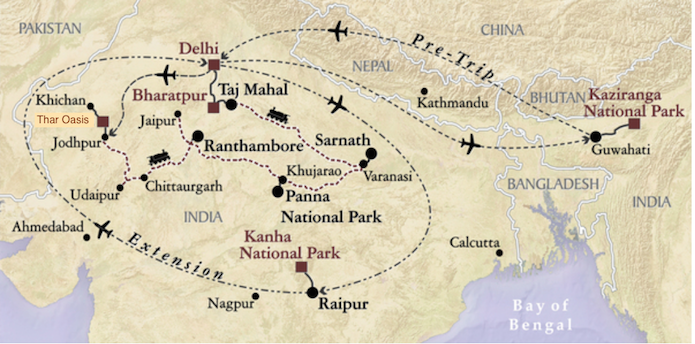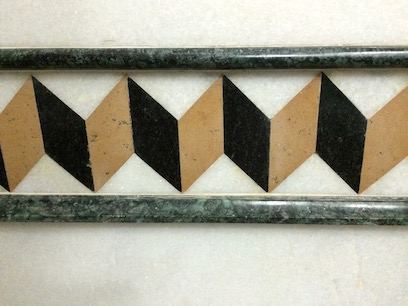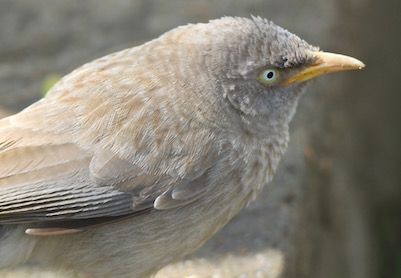
Today we continued exploring the Bharatpur area
(Image courtesy of VENT)
(Click on images to enlarge)

 Marble inlay, Bharatpur |
Before we went out this morning, I took a moment to photograph some of the marble inlay in our bathroom. We see such cunning craftsmanship everywhere we turn here. |
| We set out on this morning’s expedition in fairly heavy rain. Our goal was an area of fallow fields near the village of Khumher. The fields belong to one of the agricultural colleges and are known as being good for grassland birds. Looking at it from the highway, one wouldn’t expect the area to have any birds at all, but the birding was sensational. Fortunately, by the time we arrived, the rain had stopped, though everything was really wet. Right out of the bus, we had a new bird, the Black Francolin, two of them. The star attraction of the area is the Indian Courser, a gorgeous bird, and we saw many of them, though they are wary and didn’t let us get close. |
 Male Black Francolin (Image courtesy of Wikimedia Commons) |
 Indian Courser, Keoladeo National Park (Image courtesy of Wikimedia Commons) |
| We had three kinds of pipits as well, plus Crested Lark and other new birds for the trip, including Yellow-wattled Lapwing. One delight was watching a pair of Spotted Owlets preening one another. We were amused to see a beautiful Long-legged Buzzard being ganged up on by the unusual combination of House Crows, Red-wattled Lapwings, and Rose-ringed Parakeets. |
 Crested Lark, Khumher (Image courtesy of Amy Sheldon) |
 Has no patience with Long-legged Buzzards (Red-wattled Lapwing, Khumher) (Image courtesy of Amy Sheldon) |
|
We’d gotten very muddy walking about in the field, so before getting back
onto the bus, we walked along the road playing in the puddles for a while and
getting still more birds. This attracted the attention of the children from the
village about half a kilometer off, and they were soon lined up along the road
behind us, smiling shyly and giggling whenever we addressed any of them.
When our boots were clean enough, we waved goodbye to the children and drove back toward Bharatpur. Dion had promised us that our next stop would be at the “Painted-Snipe Place”: |
|
The Painted-Snipe Place, Bharatpur |
Male Greater Painted-Snipe, Bharatpur |
 Grey Hornbill, Bharatpur (Image courtesy of Amy Sheldon) |
 Jungle Babbler, Bharatpur (Image courtesy of Amy Sheldon) |
|
After Amy and Zach left, we clambered into our bus to drive to the national
park. On our way through town, I noticed a small truck stopped in traffic.
It was filled with freshly-harvested mustard plants, some of them hanging over
the sides, from where a very contented passing cow was happily munching them.
At the park, we returned to our regular rickshaws for another attempt at some of the more elusive birds. Our driver from yesterday greeted me with a very soft-voiced, “Good afternoon.” While we waited for the others to finish in the shop, I asked if I might take his photograph, to which he assented. When I was showing him the result, one of the other drivers, who wore a pink turban and magnificent white facial hair and had a distinct twinkle in his eye, came over to let me know that he was the handsome one and more worth photographing, so I was able to photograph him, too. |
 Our bicycle-rickshaw driver, Keoladeo National Park |
 Handsome bicycle-rickshaw driver, Keoladeo National Park |
| The first bird we searched for was the Siberian Rubythroat (Calliope calliope), a relative of the Bluethroat. It is a skulker, so we needed a good deal of effort to see it, but we did and I had an excellent look. That crimson throat just glows, even with the bird deep in the shade. What a treat! I recommend this video to give you a better idea of this stunning little bird. |
 Male Siberian Rubythroat (Image courtesy of Wikimedia Commons) |
|
While we were still in that area, Dion introduced Mr. Bholu Abrar Khan to us,
telling us that he is the hero who is most responsible for this wonderful
preserve. Mr. Khan is retired now (he was the Chief Forest Ranger at the park
for more than twenty years), but still shows up at the park most days. He has
a warm Buddha face. Poking around on the web, I found that one of his sons has
posted some of Mr. Khan’s photographs from his years at Bharatpur; I
especially liked the one of a
Fishing Cat
and her kitten, which must have required great patience to take.
From there, we went back to the Orange-headed Thrush place we searched yesterday, but we’d barely gotten there when loud claps of thunder sounded. We had just enough time to run into an open-sided shelter to get out of the monsoon-type rain that ultimately included hailstones, even with the sun shining and a rainbow. While we were sheltering, I experimented with photographing a Black-rumped Flameback with my iPhone through my binoculars (and the downpour). I did better with the charpoy in the shelter, such a perfect piece of craftsmanship. |
 Black-rumped Flameback, Keoladeo National Park |
 Charpoy, Keoladeo National Park |
| My birds for the day: |
| Comb Duck | Black Francolin | Indian Peafowl | Grey Heron | Eastern Great Egret |
| Eastern Cattle Egret | Egyptian Vulture | Booted Eagle | Long-legged Buzzard | White-breasted Waterhen |
| Black-winged Stilt | Yellow-wattled Lapwing | Red-wattled Lapwing | Greater Painted Snipe | Common Sandpiper |
| Green Sandpiper | Wood Sandpiper | Common Redshank | Ruff | Indian Courser |
| Chestnut-bellied Sandgrouse | Rock Pigeon | Laughing Dove | Spotted Owlet | White-throated Kingfisher |
| Green Bee-eater | Indian Roller | Brown-headed Barbet | Black-rumped Flameback | Common Kestrel |
| Rose-ringed Parakeet | Isabelline Shrike | Long-tailed Shrike | Southern Grey Shrike | Black Drongo |
| House Crow | Greater Short-toed Lark | Crested Lark | Grey-headed Canary-Flycatcher | Red-vented Bulbul |
| White-eared Bulbul | Hume’s Leaf Warbler | Lesser Whitethroat | Common Babbler | Large Grey Babbler |
| Indian Robin | Oriental Magpie-Robin | Siberian Rubythroat | Desert Wheatear | Tickell’s Thrush |
| Bank Myna | Common Myna | Asian Pied Starling | Brahminy Starling | Citrine Wagtail |
| Grey Wagtail | Paddyfield Pipit | Long-billed Pipit | Tawny Pipit |

